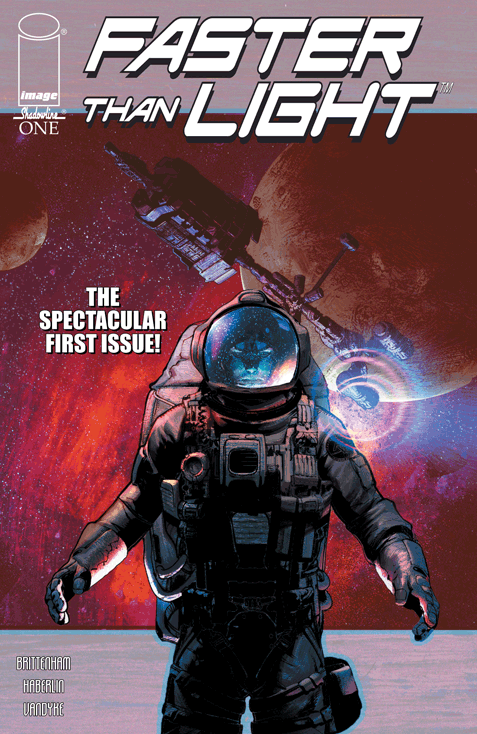In the near future, the ability to travel at lightspeed has become a reality and, as a result, a new space mission has been hastily cobbled together to investigate an extraterrestrial threat in Brian Haberlin's "Faster Than Light" #1. This much is explained in due course within the introductory issue, although Haberlin sprinkles it amidst a space freighter full of exposition and character backstory, making for a slow introduction that doesn't fully capitalize on his and Skip Brittenham's own enticing idea. Recognizing that characterization drives a good story, Haberlin tries to force in too much of it too soon.
The off-putting first page is little more than an ad for a mobile app intended to enhance the reading experience. At first glance, the ad appears to be a text/graphical mockup that somehow fits into the context of the yet-untold story but, upon reading, it's clear it is a little bit of multimedia self-promotion. No harm in that, but it sends a message that the delivery method is literally put in front of the story.
Haberlin's first issue teases a great epic but holds off on anything that might truly indicate this series will be one. Along with colorist Geirrod Van Dyke, Haberlin's faraway looks at future-tech spacecraft, deep space backdrop and alien landscapes are all gorgeously illustrated, but up close everything is painfully mundane and pedestrian. If this is a deliberate attempt at a Ridley Scott kind of futuristic, broken in look, it's one that's carried on far too long and hammered home way too hard. Artistically, it works, as the plain, unremarkable interior confines the dangerous and wondrous galaxy that surrounds it; story-wise, though, the drawn out dialogue about the way the astronauts would introduce themselves to an alien species is almost painful, and the tension between a demoted captain and her shipmates is akin to walking in on a conversation between a group of strangers and discovering it's not really one worth joining.
Haberlin doesn't seem to enjoy drawing the characters as much as high tech spaceships; his work at this level is competent, but some of his figures look stiff and he labors a little too much on facial structure, which isn't necessary as most are recognizable enough without over-delineation of their facial features. It's not until the final pages of the issue where the focus moves from exposition to exploration that Haberlin's story starts to show some signs of its potential, and it's just enough to provide an indication that this issue's shortcomings just might result from being the first part of a story written for an eventual collected edition.
If readers can make it through the plodding pace of "Faster Than Light" #1, they might find it provides a semi-capable introduction to a series that has the potential to get better.

